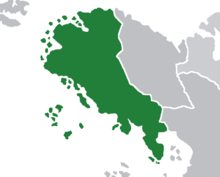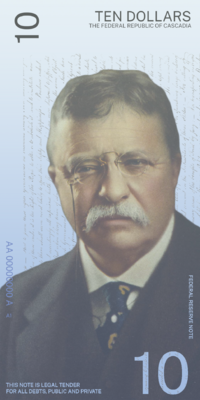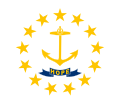Cascadia
Federal Republic of Cascadia | |
|---|---|
|
Flag | |
| Motto: "God and My Right" | |
| Anthem: Cascadia Forever | |
 | |
| Capital | Juneau |
| Official languages | Cascadian |
| Ethnic groups (2020) | |
| Religion (2021) |
|
| Demonym(s) | Cascadian |
| Government | Federal presidential constitutional republic |
| Thomas Wilson | |
| Legislature | Congress |
| Senate | |
| House of Delegates | |
| Independence from | |
| Area | |
• Total area | 902,911.77 sq mi (2,338,530.7 km2) (5th) |
| Population | |
• 2022 estimate | |
• Density | 141.02/sq mi (54.4/km2) |
| GDP (nominal) | 2021 estimate |
• Total | |
• Per capita | |
| Gini (2020) | medium |
| HDI (2021) | very high |
| Currency | Cascadian Dollar ($) (CSD) |
| Date format | mm/dd/yyyy |
| Driving side | right |
| Calling code | +2 |
The Federal Republic of Cascadia, commonly known as Cascadia is a country located in northwest Altaris. It consists of 22 states which are governed by a federal government. It shares land borders with Nordmarken-Flachland to the east and Wattenmeer to the south and has maritime borders with Khozhlod to the west. Cascadia's 12 states and 3 territories span a combined 902,911.77 square miles in territory and have a total population of approximately 127 million as of 2022. The national capital of Cascadia is Juneau, the country's largest city and main cultural and commercial center; other major urban areas include Dartmouth, Newport, Oak Harbor, Provincetown, Port MacNeil, Charlestown, Ketchikan, and Elizabethtown.
Cascadia was first settled by humans during the neolithic period, however it remained sparsely populated until the middle ages except for the southeast which was settled by early Germanic tribes. During the middle ages, colonists from the Kingdom of Great Mercia began to settle along the north and west coasts of Cascadia, and soon formed fledging settlements and colonies, Over time, the Mercian colonies grew and became economically productive, settling further and further inland. During the 18th century, a quarrel over political representation and economic policy led to a revolution against the Mercian authorities. After the revolution, Cascadia became independent, forming its own federal republic. Cascadia grew and industrialized over the following decades, its location on the northwest coast of Altaris being prime to access the circular trade currents which flow south to Isica and east from Eigonia. Continuing the trend of expansion, the Cascadian republic continued to settle and expand inland into its claimed territory, coming into occasional conflict with the Native Cascadian tribes which already resided in the northern mountain and taiga.
In the mid 19th century, an ambitious Cascadian general, Lawrence Cooper, was elected President and later appointed Dictator. During the 12 years of his reign, Cooper led Cascadia on multiple successful campaigns against their neighbors, called the Laurentian Wars, which greatly expanding Cascadian territory and subjugated the rest. Cooper's reign, while violent, also brought many social, political, and economic reforms to Cascadia and its neighbors. However, a failed incursion into Khozhlod opened the way for a coalition victory over the Cascadian forces and the ousting of Cooper and his clique. The Cascadian defeat led to a period of relative Cascadian decline which lasted until the late 19th century.
This decline began to reverse when subsequent decades saw a period of economic prosperity and cultural and scientific flourishing known as the Beautiful Era, with Cascadia reestablishing itself as a great power by 1900. However, political and social reform lagged behind the rate of industrialization. Tumultuous poltiicals saw the rise and fall of many successive governments. Corruption, monopolies, and the concentration of wealth was rife throughout Cascadian society. And abject poverty, destitution, and moral degeneration was commonplace in the lower classes. To combat this, the rising middle-class, labor unions, and religious groups began to demand major political and economic reforms to Cascadia itself.
This came to a head with the meteoric rise, and subsequent election, of William A. Smith and his Federalist Party in 1934. A self-described progressive, Smith and his party overhauled the Cascadian economic and political system. Smith sought to fight these social, economic, and political ills by advancing democracy, scientific methods, professionalism, and efficiency; regulating business, protecting the natural environment, and improving working conditions in factories and living conditions of the lower classes. Smith's policies were immensely popular and successful, and as a result his party remains dominant in Cascadian politics to this day.
The Cascadian government is a federal republic and a representative democracy with three separate branches of government: executive, legislative, and judicial. It has a bicameral national legislature composed of the House of Delegates, a lower house based on population; and the Senate, an upper house based on equal representation for each state. Many policy issues are decentralized at a state or local level. It ranks among the highest in the world in international measures of quality of life, income, wealth, economic competitiveness, education, and innovation.
Cascadia wields considerable global influence as the one of the world's foremost political, cultural, economic, military, and scientific powers. Cascadia is a founding member of the International Council of Nations and NAMDO.
History
Early human settlement
Germanic tribes
Great Crusade
Mercian conquest
Colonial period
Revolution
Early republic
Cooper's dictatorship
Lawrence Cooper, in an electoral upset, seized control of the republic and was elected as president in 1835 and subsequently appointed dictator, an extraordinary position of authority.
Decline
Beautiful Era
Rise of Progressivism
Smith's presidency
20th century
Contemporary period
Geography
By total area, Cascadia is the fifth-largest country in the world. Spanning from the Arctic Ocean to the north to the PLACEHOLDER Ocean to the west and PLACEHOLDER Ocean to the south, the country encompasses 902,911.77 sq mi (2,338,530.7 km2) of territory. Cascadia shares a land border with Nordmarken, Wattenmeer, and a maritime boundary with Khozhlod and Great Mercia. Cascadia is home to the northernmost settlement on Altaris at PLACEHOLDER.
Cascadia is divided into PLACEHOLDER physiographic regions: ...
Climate
Biodiversity
Government and politics
Cascadia is a federal constitutional republic of 12 states and 3 territories. It is one of the world's oldest surviving federations, in which power is divided between the federal and the provincial and territorial governments. Cascadia is a representative democracy in which "majority rule is tempered by minority rights protected by law".
The Cascadian constitution serves as the country's supreme legal document, establishing the structure and responsibility of the federal government and its relationship with the individual states.
Ever since the early 20th century with the election of President William A. Smith, Cascadia has operated under what some scholars call a "loose dominant-party system" where the generally right wing Federalist Party has dominated elections, both presidential and legislative, with brief interludes of electoral failure. In the current Cascadian political culture, the Federalist Party is dominant, its respective factions vying for power, with the left-wing National Democratic Party and progressive Farmer–Labor Party in opposition.
Federal government
The federal government is separated into three branches:
- Legislature: the bicameral Congress, comprising the Senate and the House of Delegates.
- Executive: the president and his cabinet.
- Judiciary: The Supreme Court of Cascadia and other federal courts, whose judges are appointed by the president with approval from the Congress.
In the Senate (the upper house), there are 126 senators: ten from each of the 12 states and 2 from the 3 territories. The House of Delegates has 650 members elected from single-member electoral divisions, commonly called "delegacies" or "seats", allocated to the states on the basis of population, each of which roughly contains 200,000 people. Elections for both chambers are normally held every three years simultaneously; senators have overlapping six-year terms.
Executive power is wielded by the President who is elected for a 5-year term with the possibility of re-election for a second consecutive term. The current president is Thomas Wilson. The president appoints cabinet members who assist in governance.
The Supreme Court, led by the chief justice of Cascadia, has nine members, who serve for life. They are appointed by the sitting President when a vacancy becomes available.
States and territories
Each of the 22 states holds jurisdiction over a geographic territory, where it shares sovereignty with the federal government. They are subdivided into counties, and further divided into municipalities.
Citizenship is granted at birth in all states and territories.
Cascadia observes limited tribal sovereignty of the Cascadian Indigenous nations.
States
Foreign relations
Military
Economy
Overview

Cascadia has a mixed market economy, characterized by substantial government involvement, economic diversity, a strong industrial base, and a skilled workforce. Cascadia is the third-largest economy globally by nominal GDP and has the second-highest nominal GDP per capita. Cascadia is considered an economic power.
Agriculture
Tourism
Energy
Transport
Science and technology
Demographics
Population
Language
Religion
Urbanization
Education
Health
Culture and society
Cascadians have traditionally been characterized by a unifying belief in liberty, equality under the law, democracy, property rights, honesty, social altruism, and a desire to wander.
Cascadian culture owes many of its roots to the country's Mercian forebears as well as the other minor groups of Germanic settlers who assimilated into Cascadia.














